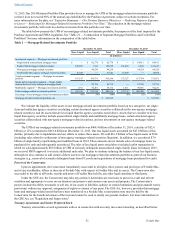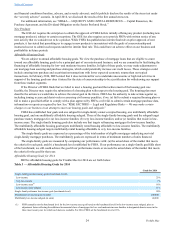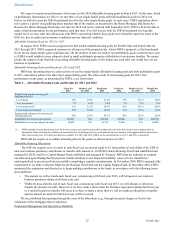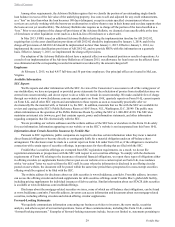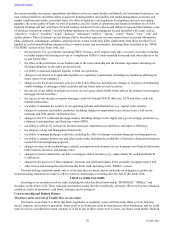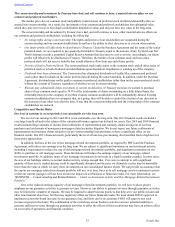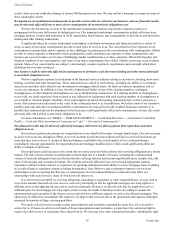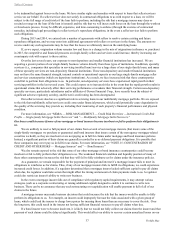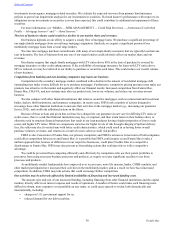Freddie Mac 2014 Annual Report Download - page 33
Download and view the complete annual report
Please find page 33 of the 2014 Freddie Mac annual report below. You can navigate through the pages in the report by either clicking on the pages listed below, or by using the keyword search tool below to find specific information within the annual report.
28 Freddie Mac
FHFA’s Strategic Plan for Freddie Mac and Fannie Mae Conservatorships
In May 2014, FHFA issued its 2014 Strategic Plan and the 2014 Conservatorship Scorecard. The 2014 Strategic Plan
updated FHFA's vision for implementing its obligations as Conservator of Freddie Mac and Fannie Mae (the “Enterprises”).
The 2014 Conservatorship Scorecard established objectives and performance targets and measures for 2014 for the Enterprises
related to the strategic goals set forth in the 2014 Strategic Plan. On January 14, 2015, FHFA issued the 2015 Conservatorship
Scorecard, which establishes objectives and performance targets and measures for 2015 for the Enterprises related to the
strategic goals set forth in the 2014 Strategic Plan.
The 2014 Strategic Plan established three reformulated strategic goals for the conservatorships of Freddie Mac and Fannie
Mae:
• Maintain, in a safe and sound manner, foreclosure prevention activities and credit availability for new and refinanced
mortgages to foster liquid, efficient, competitive and resilient national housing finance markets.
• Reduce taxpayer risk through increasing the role of private capital in the mortgage market.
• Build a new single-family securitization infrastructure for use by the Enterprises and adaptable for use by other
participants in the secondary market in the future.
As part of the first goal, the 2014 Strategic Plan describes various steps related to increasing access to mortgage credit for
credit-worthy borrowers. The 2014 Strategic Plan provides for the Enterprises to continue to play an ongoing role in supporting
multifamily housing needs, particularly for low-income households. The plan states that FHFA will continue to impose a
production cap on Freddie Mac’s and Fannie Mae’s multifamily businesses.
The second goal focuses on ways to transfer risk to private market participants and away from the Enterprises in a
responsible way that does not reduce liquidity or adversely impact the availability of mortgage credit. The second goal provides
for us to increase the use of single-family credit risk transfer transactions, continue using credit risk transfer transactions in the
multifamily business and continue shrinking our mortgage-related investments portfolio consistent with the requirements in the
Purchase Agreement, with a focus on selling less liquid assets.
The third goal includes the continued development of the Common Securitization Platform. FHFA refined the scope of
this project to focus on making the new shared system operational for Freddie Mac’s and Fannie Mae’s existing single-family
securitization activities. The third goal also provides for the Enterprises to work towards the development of a single (common)
security.
We continue to align our resources and internal business plans to meet the goals and objectives provided to us by FHFA.
For information about the 2014 Conservatorship Scorecard, and our performance with respect to it, see “EXECUTIVE
COMPENSATION — Compensation Discussion and Analysis.” For information about the 2015 Conservatorship Scorecard,
see our current report on Form 8-K filed on January 15, 2015.
FHFA Request for Input on Proposed Single Security Structure
In August 2014, FHFA published a request for input on the proposed structure for a single security that would be issued
and guaranteed by Freddie Mac or Fannie Mae. FHFA requested comment on all aspects of the proposed structure. Under
FHFA’s proposal, the single security would leverage the enterprises’ existing security structures, and would encompass many of
the pooling features of the current Fannie Mae mortgage backed security and most of the disclosure framework of the current
Freddie Mac PC. FHFA stated that its goal for the proposed single security structure is for legacy Freddie Mac PCs and legacy
Fannie Mae mortgage backed securities to be fungible with the single security for purposes of fulfilling TBA contracts. FHFA
also stated that the development of the single security will be a multi-year effort, and that FHFA, Freddie Mac and Fannie Mae
will continue to seek input and work with stakeholders throughout the process to achieve the goal of improving overall
secondary mortgage market liquidity while mitigating any risk of market disruption.
FHFA Request for Input on Guarantee Fees
In June 2014, FHFA published a request for input on the guarantee fees that we and Fannie Mae charge lenders. FHFA’s
request for input included questions related to guarantee fee policy and implementation regarding the optimum level of
guarantee fees required to protect taxpayers and implications for mortgage credit availability. We cannot predict what changes,
if any, FHFA will require us to make to our guarantee fees as a result of this request.
FHFA Advisory Bulletin
In April 2012, FHFA issued Advisory Bulletin AB 2012-02, “Framework for Adversely Classifying Loans, Other Real
Estate Owned, and Other Assets and Listing Assets for Special Mention” (the “Advisory Bulletin”), which is applicable to
Fannie Mae, Freddie Mac and the FHLBs. The Advisory Bulletin establishes guidelines for adverse classification and
identification of specified single-family and multifamily assets and off-balance sheet credit exposures. The Advisory Bulletin
indicates that this regulatory guidance considers and is generally consistent with the Uniform Retail Credit Classification and
Account Management Policy issued by the federal banking regulators in June 2000.
Table of Contents





